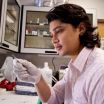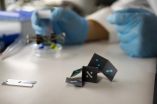(Press-News.org) In the nearly five decades since the first lunar surveys were conducted as part of NASA's Apollo program, scientists have advanced a number of increasingly complex theories to explain the vast swaths of highly magnetic material that had been found in the some parts of the Moon's crust.
But now a team of researchers from Harvard, MIT and the Institut de Physique du Globe de Paris, have proposed a surprisingly simple explanation for the unusual findings – the magnetic anomalies are remnants of a massive asteroid collision. As described in a paper published March 9 in Science, the researchers believe an asteroid slammed into the moon approximately 4 billion years ago, leaving behind an enormous crater and iron-rich, highly magnetic rock.
While there is evidence that the Moon once generated its own magnetic field, there is little to suggest it was strong enough to account for the anomalies seen in earlier surveys, Sarah Stewart-Mukhopadhyay, the John L. Loeb Associate Professor of the Natural Sciences, and one of three co-authors of the paper, said. To explain the findings, then, researchers turned to a number of elaborate scenarios.
"The conundrum has always been that the magnetism we see on the Moon is not correlated with any surface geology," she said. "The theory that has been most commonly cited to explain it is an 'impact-induced field,' in which an impact concentrates and amplifies the Moon's magnetic field. But it was difficult to test – people have tried to model it, but it is right at the edge of what could work.
"We have a simpler idea," she continued. "Because the fields in this area are stronger than those found in any normal lunar rocks, our hypothesis is that it isn't lunar material. We know the magnetic properties of asteroidal material are much higher than that of the Moon. It is possible that metallic iron from an asteroid could have been magnetized by the impact, and deposited on the Moon."
Ironically, their first clue came from the surveys that had long confounded scientists.
When combined with more recent, hyper-accurate topographical surveys of the Moon's surface, it quickly became clear that most of the magnetic anomalies are scattered around the rim of an enormous, 2,400 kilometer-diameter crater known as South Pole-Aitken.
The oldest definitive structure on the Moon, the crater is between 3.9 and 4.5 billion years old, and is slightly elongated, suggesting it was formed by an object that struck the moon at an oblique angle.
Testing that hypothesis, however, proved tricky.
"The question was whether the projectile material could survive and stay on the Moon, and where it would end up," Stewart-Mukhopadhyay said. "What I did was model the impact and formation of the basin using computer codes that are typically used to model explosives."
To create those models, Stewart-Mukhopadhyay started with "equations of state," mathematical formulas that describe the asteroid and the Moon's crust, mantle and core. The far trickier part of modeling the impact, however, is in describing the rheology – the conditions under which each material deforms and flows.
"We modeled a number of scenarios using faster or slower impacts and more shallow or more vertical angles," she said. "Each time, the model produced similar results to what we see on the Moon."
Beyond its surprisingly simple explanation to a decades-old scientific puzzle, the paper suggests new ways to answer questions about what the early solar system was like, and how the magnetic fields of the planets were formed.
"We don't have much evidence of what was hitting the Earth before 3.9 billion years ago," Stewart-Mukhopadhyay said. "And there are some big questions about where those projectiles were coming from. Presumably if you picked up even the soil from this part of the Moon, you would have some of the material that came along with this large impact event.
"It may also be true that extra-terrestrial materials play a larger role in the magnetic fields of other planets than anyone has appreciated," she continued. "Magnetism is one of the clues that let us construct a geologic history of the surface of a planet. If we now have to consider that it may have come from a collision like this one, that's something we need to be aware of."
INFORMATION: END
Cambridge, Mass. - March 8, 2012 - Researchers in applied physics have cleared an important hurdle in the development of advanced materials, called metamaterials, that bend light in unusual ways.
Working at a scale applicable to infrared light, the Harvard team has used extremely short and powerful laser pulses to create three-dimensional patterns of tiny silver dots within a material. Those suspended metal dots are essential for building futuristic devices like invisibility cloaks.
The new fabrication process, described in the journal Applied Physics Letters, advances ...
Toronto – Countries that more strictly uphold their cultural norms are less likely to promote women as leaders – unless those norms support equal opportunity for both sexes, shows a new paper from the University of Toronto's Rotman School of Management.
"Cultural tightness can prevent the emergence of women leaders because tighter cultures may make a society's people more resistant to changing the traditionally-held practice that placed men in leadership roles," says Prof. Soo Min Toh, who is cross-appointed to the Rotman School and the University of Toronto Mississauga, ...
Winston-Salem, N.C. – March 8, 2012 -- Maternal obesity may contribute to cognitive impairment in extremely premature babies, according to a new study by researchers at Wake Forest Baptist Medical Center.
"Although in the past decade medical advances have improved the survival rate of babies born at less than seven months, they are still at very high risk for mental developmental delays compared with full-term infants," said Jennifer Helderman, M.D., assistant professor of pediatrics at Wake Forest Baptist and lead author of the study. "This study shows that obesity doesn't ...
Washington, DC – A collaborative team of researchers at Children's National Medical Center are making progress in understanding how to protect infants needing cardiac surgery from white matter injury, which impacts the nervous system. The synergistic team from the Children's National Heart Institute and Center for Neuroscience Research at Children's National Medical Center was led by Nobuyuki Ishibashi, MD, Joseph Scafidi, DO, Richard Jonas, MD, and Vittorio Gallo, PhD. The study, published online in the January edition of Circulation, identifies the stages of white matter ...
Philadelphia, PA, March 6, 2012 – The Canadian Journal of Cardiology has published a paper on the effect of socioeconomic factors on myocardial infarction outcomes.
This study describes an analysis of the effect of socioeconomic class on outcomes after a first myocardial infarction ("heart attack"). The study analyzed detailed databases in Quebec and found that socioeconomic deprivation did not negatively affect access to the most advanced high-level health care – clearly a success for the Canadian public healthcare system. Nevertheless, mortality rates were slightly ...
AUSTIN, Texas — Inspired by the paper-folding art of origami, chemists at The University of Texas at Austin have developed a 3-D paper sensor that may be able to test for diseases such as malaria and HIV for less than 10 cents a pop.
Such low-cost, "point-of-care" sensors could be incredibly useful in the developing world, where the resources often don't exist to pay for lab-based tests, and where, even if the money is available, the infrastructure often doesn't exist to transport biological samples to the lab.
"This is about medicine for everybody," says Richard Crooks, ...
Young America, http://www.young-america.com, an incentive marketing firm, has hired Steve Schulte as senior sales executive responsible for new business development initiatives and strategic growth focusing on opportunities among large clients.
Prior to joining Young America, Schulte worked for Restaurant.com as national account manager. He previously held leadership positions in the sales departments of loyalty and incentive companies Maritz, Inc. and Meridian Enterprises, and has experience in the technology, automotive, hospitality and insurance industries. He holds ...
Sometimes the fastest pathway from point A to point B is not a straight line: for example, if you're underwater and contending with strong and shifting currents. But figuring out the best route in such settings is a monumentally complex problem — especially if you're trying to do it not just for one underwater vehicle, but for a swarm of them moving all at once toward separate destinations.
But that's just what a team of engineers at MIT has figured out how to do, in research results to be presented in May at the annual IEEE International Conference on Robotics and Automation. ...
Feeling angry and annoyed with others is a daily part of life, but most people don't act on these impulses. What keeps us from punching line-cutters or murdering conniving co-workers? Self-control. A new review article in Current Directions in Psychological Science, a journal of the Association for Psychological Science, examines the psychological research and finds that it's possible to deplete self-control—or to strengthen it by practice.
Criminologists and sociologists have long believed that people commit violent crimes when an opportunity arises and they're low on ...
COLUMBIA, Mo. –Veterans are almost twice as likely as the general public to have chronic illnesses, such as diabetes and heart failure. Therefore, veterans may require more assistance from informal caregivers, especially as outpatient treatment becomes more common. A University of Missouri researcher evaluated strain and satisfaction among informal caregivers of veterans with chronic illnesses. The findings show that more than one third of veterans' caregivers report high levels of strain as a result of taking care of their relatives; yet, on average, caregivers also report ...

